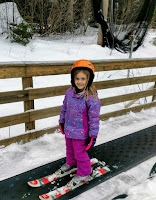When introducing or sharing about a problem, we reflect on the many different ways to solve a problem. I often ask, did anyone solve it a different way? The journal share offers inspiration and ideas. When looking through their journals, we have frequent check-ins about providing labels and ensuring organized work.
I believe math journals to be an essential part of the children's learning. While I appreciate the convenience of a workbook, I like to write our own story problems - connecting the problems to learning across contexts. For example, at the beginning of the year our focus was on community and learning about the children in our class. When introducing our math journals, the first problem was, how many friends in our community? Now, to connect our journal work to our math calendar, children have been solving button problems. It's always fun to use a Kindergartener's name in our story problems, offering a bit of ownership.
The Button Problem - solving the missing number!
The button problems have supported children's knowledge of combinations to five and recognizing these combinations quickly. At the end of Kindergarten, children should be able to consistently decompose five and ten into different parts. All of these problems support children in thinking about number combinations in different ways, supporting deeper thinking and understanding.
Anna has 5 buttons on her vest.
2 of the buttons are red and the rest are blue.
How many buttons are blue?
In the first image, the student knows their combinations to five. When presented in a different way, she is able to solve the missing number using what she knows about five. When I asked her how she would show that, she talked about checking her work. Through our journal work, another important teaching point is mathematician always check their work! Knowing this mathematician, a next step would be; Can you show this problem using a number sentence (equation)? Can you show this problem using a number tree?
In the second image, the student used a picture to determine how many buttons on Anna's vest, they then further explained in writing, "I read some of the words and I counted 5. 3 buttons". The student made sure they had five buttons total and that only three of the buttons were blue.
In the third image, the student used a frame to show their thinking. When sharing her work, a peer noted her five frame actually had 6 squares. Together, we drew another five frame. Again, the share is a second or third opportunity to reread and check your work!

For the next journaling experience, I offered two different button problems. In one, I flipped the numbers and used different colors - would they be able to solve it quickly and independently? In Kindergarten, it is often surprising how changing the colors in a story problem can cause a bit of chaos! This time, three of the buttons are purple and the rest are green. How many buttons are green?
I was surprised that no student working on this problem made the connection to the previous button problem. In retrospect, I also didn't ask if anyone noticed what was the same or different about the two problems. Perhaps we will go back as a whole class and ask the question.
I have noticed that the more often we look at our work as a community, the more children notice. We discuss how mathematicians all over the world keep journals and how important this work is - important work means you take care of your journal. Children are proud to provide neat and organized work.

During this time, I also offered a button combination challenge to a large group of students. These students can consistently decompose five quickly, but can they figure out how many button combinations?
Inez has 5 buttons on her vest.
Some are purple and some are green.
How many different combinations could she make?
In the first image, I asked, "Can you tell me how you solved this?"
The student responded with, "I thought about it". Ah, yes, spoken like a true mathematician. Notice how our conversation led to checking her work and crossing out two extra combinations. A next step for this student would be; Can you write an equation to show each button combination?
In the below image another Kindergartener used a picture to show how they solved the button combination problem. When they wrote the number six, I asked, "Six what?" She wrote, "BC" for button combinations.
Again, another student used a picture to solve and show how they solved the problem. I wonder, is there another way to solve this problem?
Sometimes, I take a math question from the morning message and put it in each of their journals with their answer. On January 25, I asked, Can you show 25?
When looking at their collective work, Kindergarteners put a hand up to share their noticings;
I notice that we showed 25 in different ways.
I notice some friends wrote 15 instead of 25.
I notice some people wrote 25 lots of times on their sticky note, that's confusing. Should we just write it once?
I notice everyone did it!




AM uses the 100's chart to record the number 25. I believe a mathematician must use their environment in addition to their knowledge to solve a problem. AM was able to independently solve two problems - the expected problem of showing 25 and the unexpected problem of not being sure how to print 25!












































